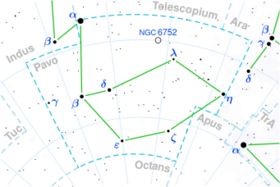Astronomy:Nu Pavonis
| Observation data Equinox J2000.0]] (ICRS) | |
|---|---|
| Constellation | Pavo |
| Right ascension | 18h 31m 22.42509s[1] |
| Declination | −62° 16′ 41.8853″[1] |
| Apparent magnitude (V) | 4.64 (4.60 - 4.64[2]) |
| Characteristics | |
| Evolutionary stage | main sequence[3] |
| Spectral type | B7III[4] |
| U−B color index | −0.39[5] |
| B−V color index | −0.11[5] |
| Variable type | SPB[2] |
| Astrometry | |
| Radial velocity (Rv) | +16.95[6] km/s |
| Proper motion (μ) | RA: −1.11[1] mas/yr Dec.: −45.31[1] mas/yr |
| Parallax (π) | 7.43 ± 0.24[1] mas |
| Distance | 440 ± 10 ly (135 ± 4 pc) |
| Absolute magnitude (MV) | -1.01[4] |
| Orbit[7] | |
| Period (P) | 1.711529±0.000005 d |
| Eccentricity (e) | 0.0 |
| Periastron epoch (T) | 2,450,276.5502±0.0007 HJD |
| Argument of periastron (ω) (secondary) | 127±12° |
| Semi-amplitude (K1) (primary) | 43.8±0.1 km/s |
| Details | |
| Mass | 4.39[8] M☉ |
| Luminosity | 659[8] L☉ |
| Temperature | 12,764[8] K |
| Rotational velocity (v sin i) | 125.0[9] km/s |
| Other designations | |
| Database references | |
| SIMBAD | data |
ν Pavonis, Latinized as Nu Pavonis, is a possible triple star system[11] in the southern constellation of Pavo. It is visible to the naked eye as a faint star that varies in apparent visual magnitude from 4.60 to 4.64 over a period of 0.85584 days.[2] The system lies approximately 440 light years from the Sun based on parallax,[1] and is drifting further away with a radial velocity of +17 km/s.[6] It is a possible member of the Wolf 630 group of co-moving stars.[3]

This is a single-lined spectroscopic binary system with an orbital period of just 1.71 days in a circular orbit.[7] The unresolved[3] components are close enough that their tidal interaction is significant.[7] The visible component is a slowly pulsating B-type star with a stellar classification of B7III.[4] This implies it is an evolved giant star, but it is actually more likely to be on the main sequence. An X-ray emission has been detected from the pair.[3]
The third component is a visible companion, probably a pre-main-sequence star, at magnitude 13.7 and separation 3.1″. This star is estimated at 0.15 solar masses and an effective temperature of 3,192 K.[8] It too is an X-ray source.[3]
References
- ↑ 1.0 1.1 1.2 1.3 1.4 1.5 Van Leeuwen, F. (2007). "Validation of the new Hipparcos reduction". Astronomy and Astrophysics 474 (2): 653–664. doi:10.1051/0004-6361:20078357. Bibcode: 2007A&A...474..653V. Vizier catalog entry
- ↑ 2.0 2.1 2.2 Watson, C. L. (2006). "The International Variable Star Index (VSX)". The Society for Astronomical Sciences 25th Annual Symposium on Telescope Science. Held May 23–25 25: 47. Bibcode: 2006SASS...25...47W.
- ↑ 3.0 3.1 3.2 3.3 3.4 Stelzer, B. et al. (September 2003). "Late B-type stars and their candidate companions resolved with Chandra". Astronomy and Astrophysics 407 (3): 1067–1078. doi:10.1051/0004-6361:20030934. Bibcode: 2003A&A...407.1067S.
- ↑ 4.0 4.1 4.2 Anderson, E.; Francis, Ch. (2012). "XHIP: An extended hipparcos compilation". Astronomy Letters 38 (5): 331. doi:10.1134/S1063773712050015. Bibcode: 2012AstL...38..331A. Vizier catalog entry
- ↑ 5.0 5.1 Ducati, J. R. (2002). "VizieR On-Line Data Catalog: Catalogue of Stellar Photometry in Johnson's 11-color system". CDS/ADC Collection of Electronic Catalogues 2237. Bibcode: 2002yCat.2237....0D.
- ↑ 6.0 6.1 Pourbaix, D. et al. (2004). "SB9: The ninth catalogue of spectroscopic binary orbits". Astronomy and Astrophysics 424 (2): 727–732. doi:10.1051/0004-6361:20041213. Bibcode: 2004A&A...424..727P.
- ↑ 7.0 7.1 7.2 De Cat, P.; Aerts, C.; De Ridder, J.; Kolenberg, K.; Meeus, G.; Decin, L. (2000). "A study of bright southern slowly pulsating B stars. I. Determination of the orbital parameters and of the main frequency of the spectroscopic binaries". Astronomy and Astrophysics 355: 1015–1030. Bibcode: 2000A&A...355.1015D.
- ↑ 8.0 8.1 8.2 8.3 Hubrig, S.; Le Mignant, D.; North, P.; Krautter, J. (2001). "Search for low-mass PMS companions around X-ray selected late B stars". Astronomy and Astrophysics 372: 152–164. doi:10.1051/0004-6361:20010452. Bibcode: 2001A&A...372..152H.
- ↑ Glebocki, R.; Gnacinski, P. (2005). "Catalog of Stellar Rotational Velocities". VizieR On-Line Data Catalog: III/244 3244. Bibcode: 2005yCat.3244....0G. Vizier catalog entry
- ↑ "nu. Pav". SIMBAD. Centre de données astronomiques de Strasbourg. http://simbad.u-strasbg.fr/simbad/sim-basic?Ident=nu.+Pav.
- ↑ Eggleton, P. P.; Tokovinin, A. A. (September 2008). "A catalogue of multiplicity among bright stellar systems". Monthly Notices of the Royal Astronomical Society 389 (2): 869–879. doi:10.1111/j.1365-2966.2008.13596.x. Bibcode: 2008MNRAS.389..869E.
- ↑ "MAST: Barbara A. Mikulski Archive for Space Telescopes". Space Telescope Science Institute. https://mast.stsci.edu/portal/Mashup/Clients/Mast/Portal.html.
 |


